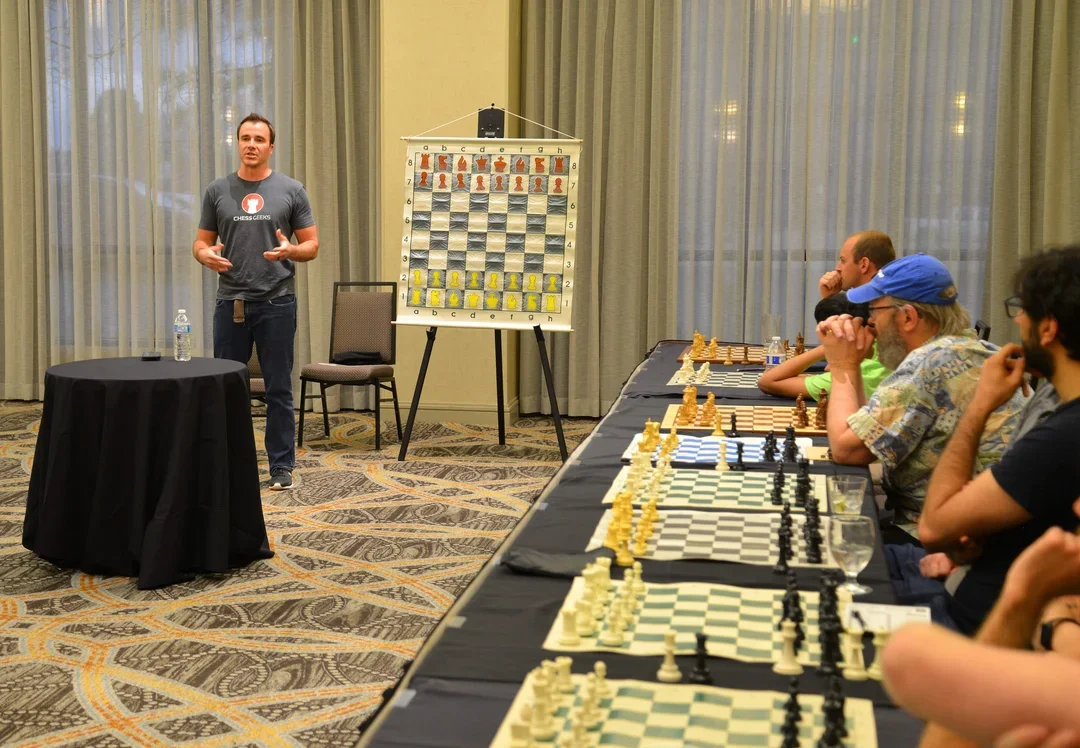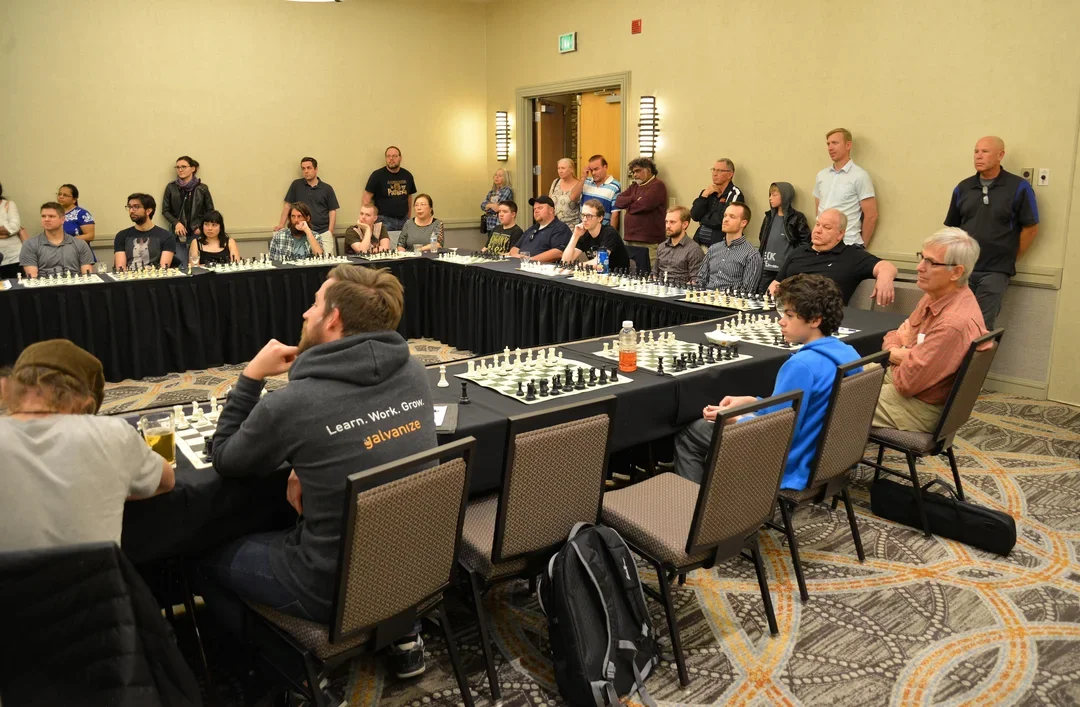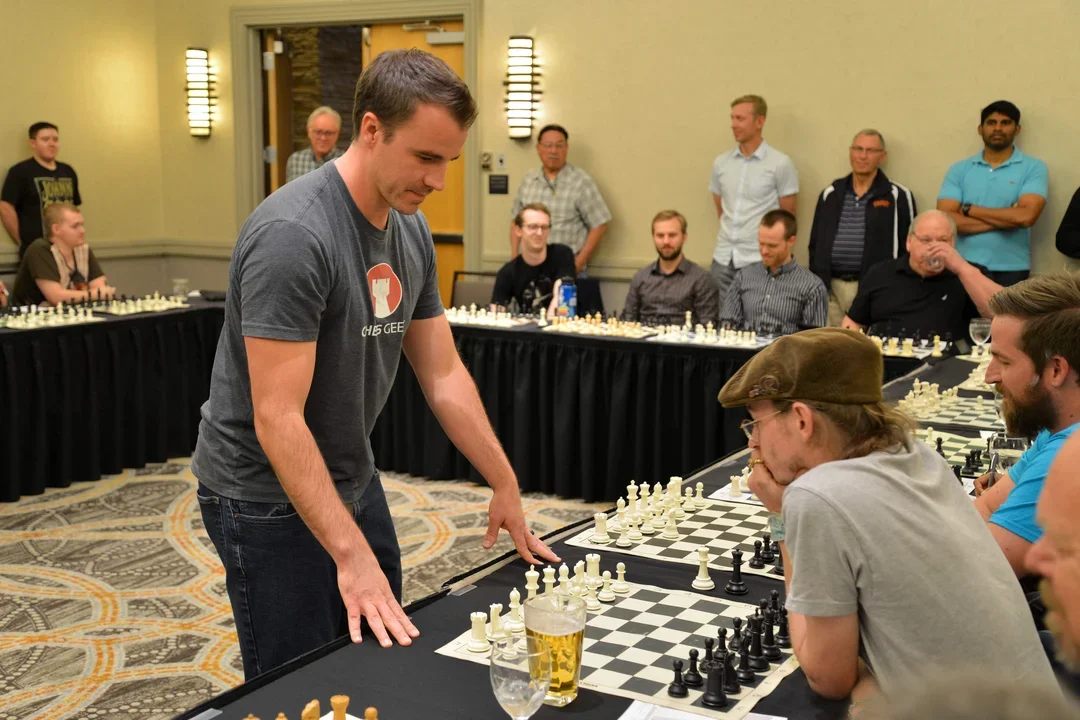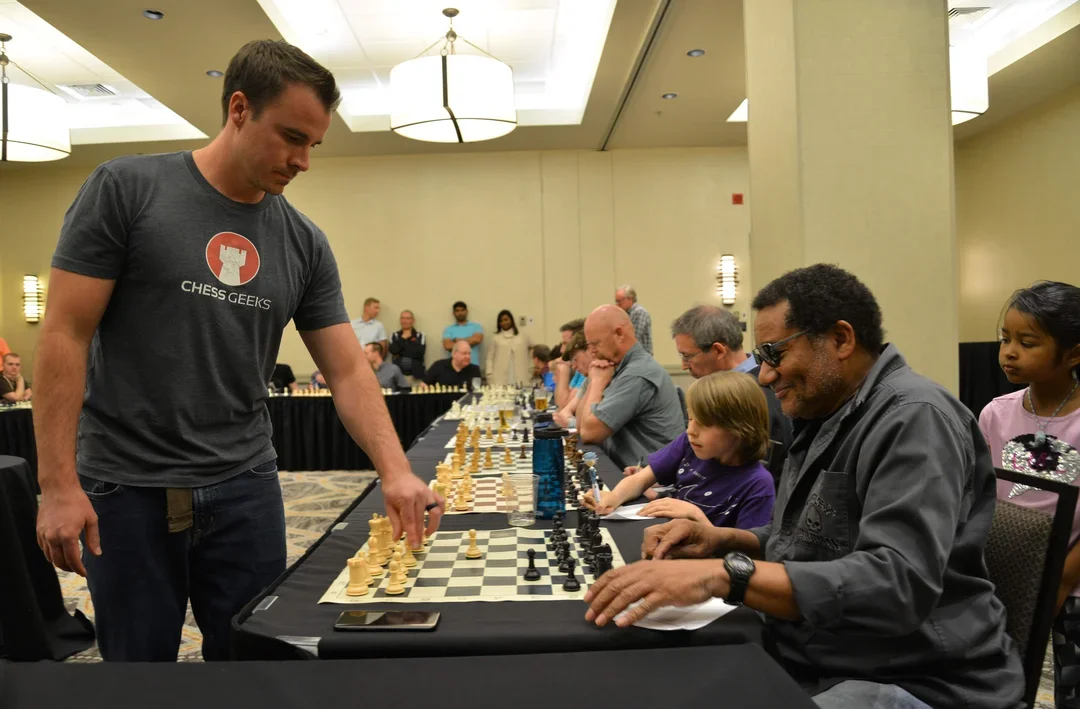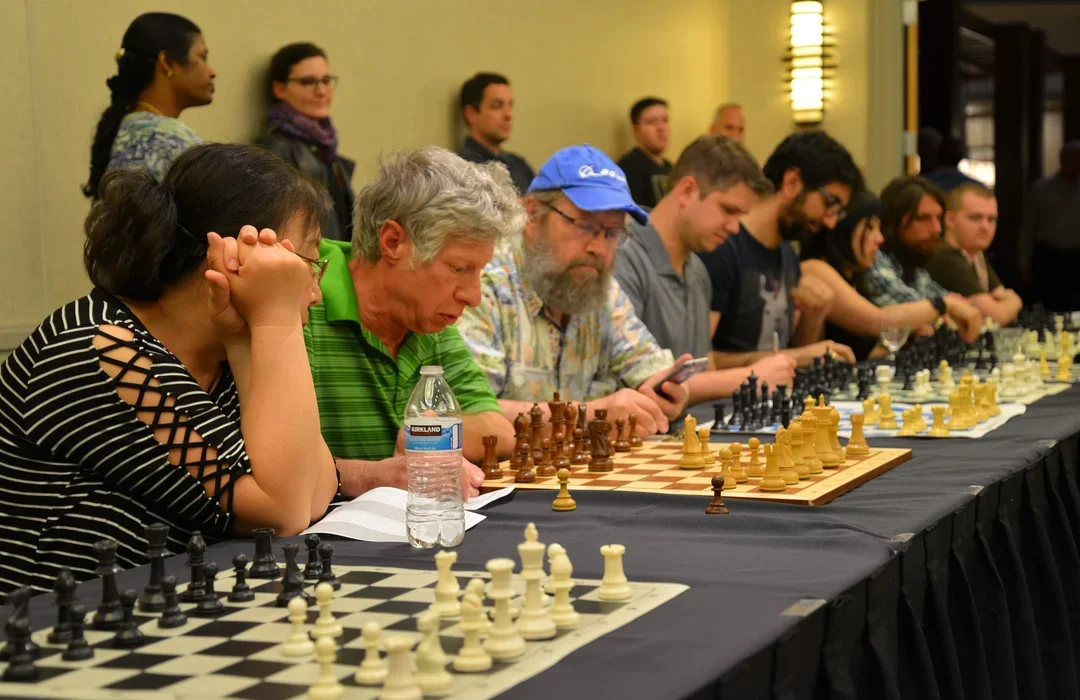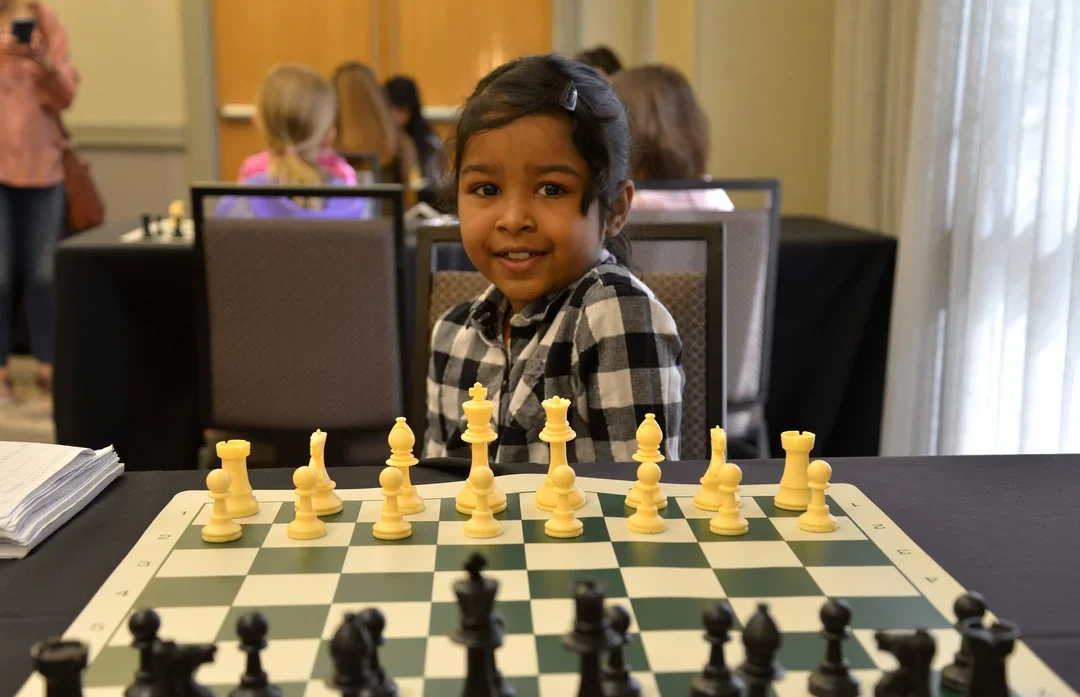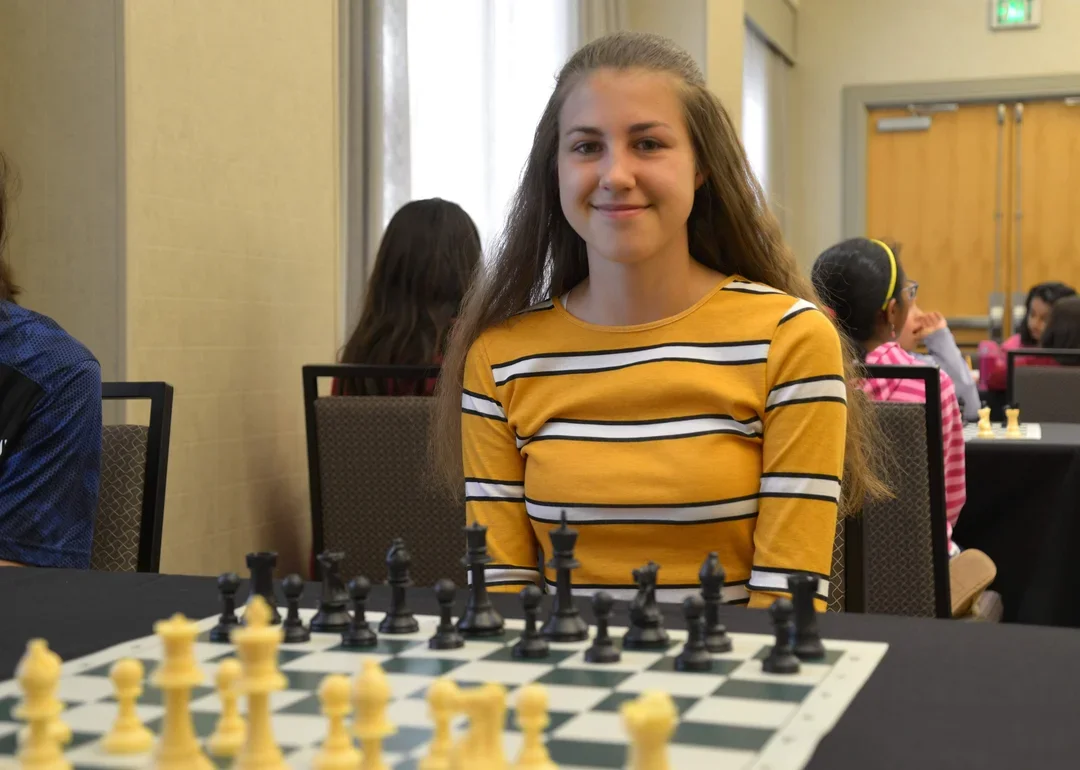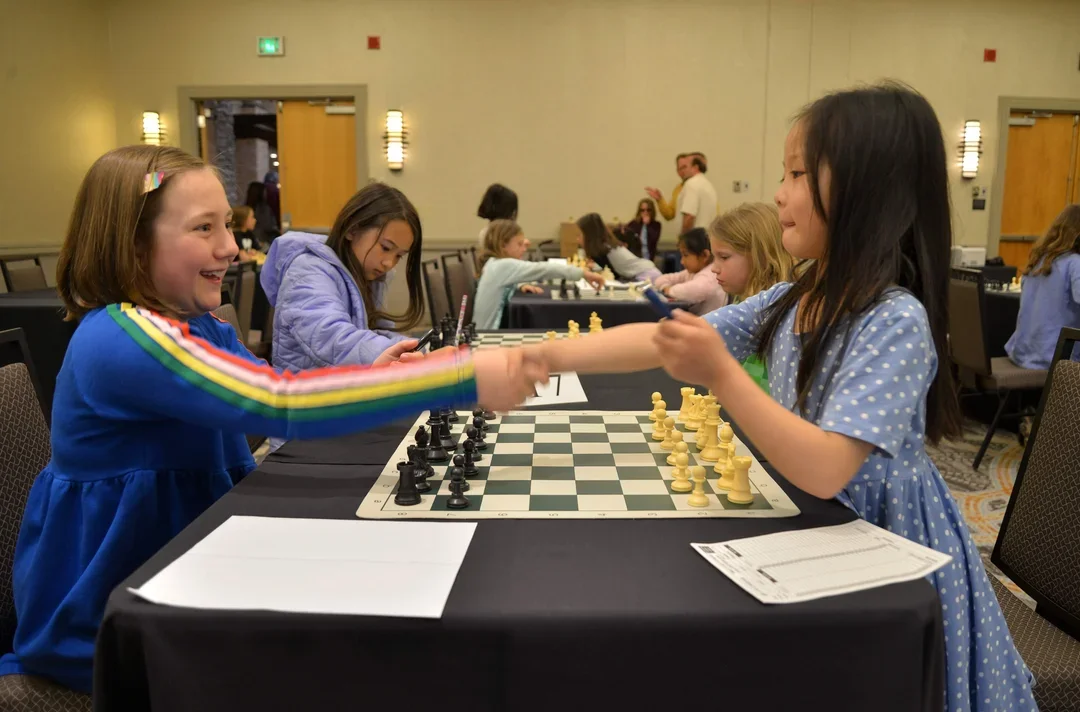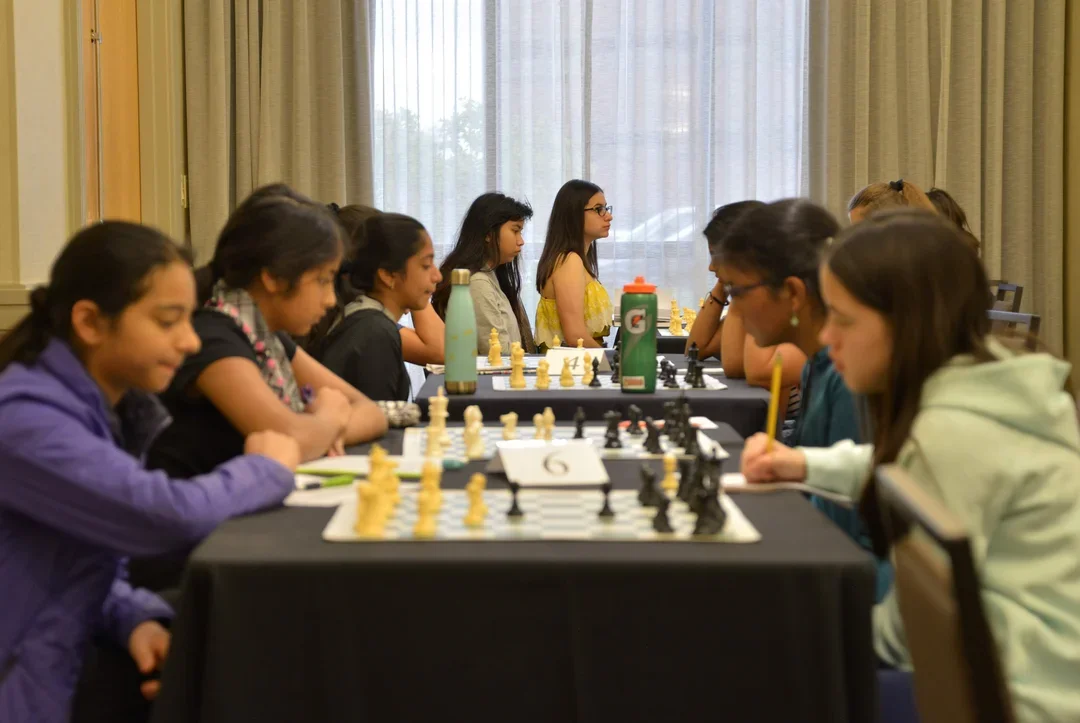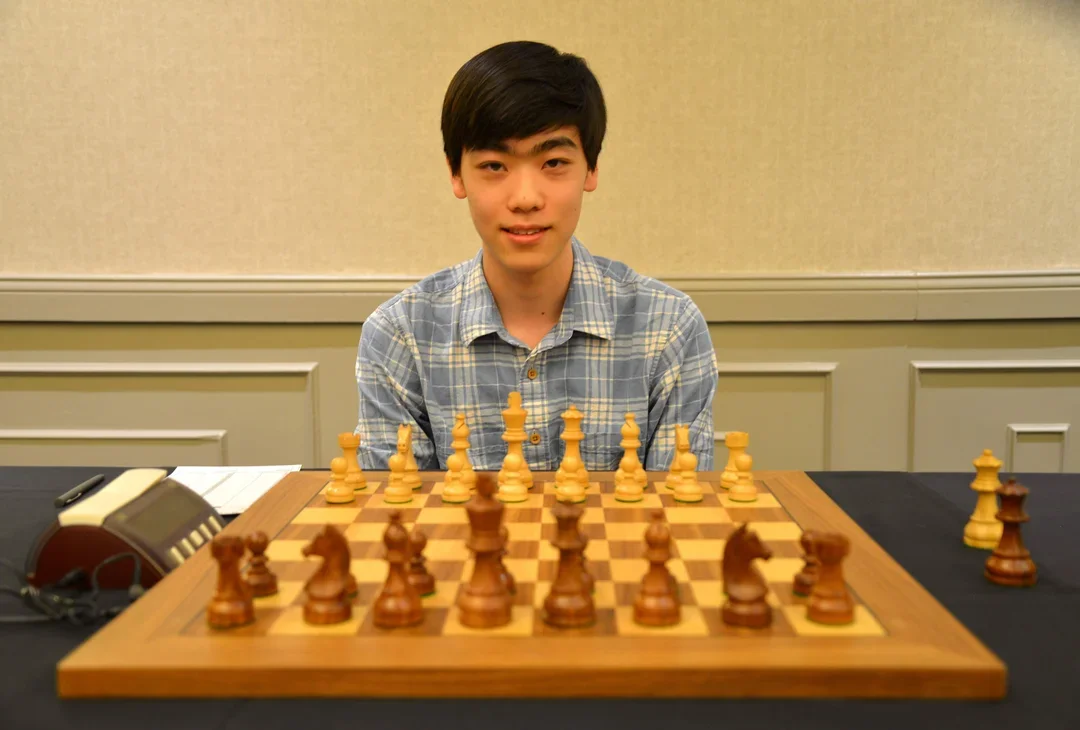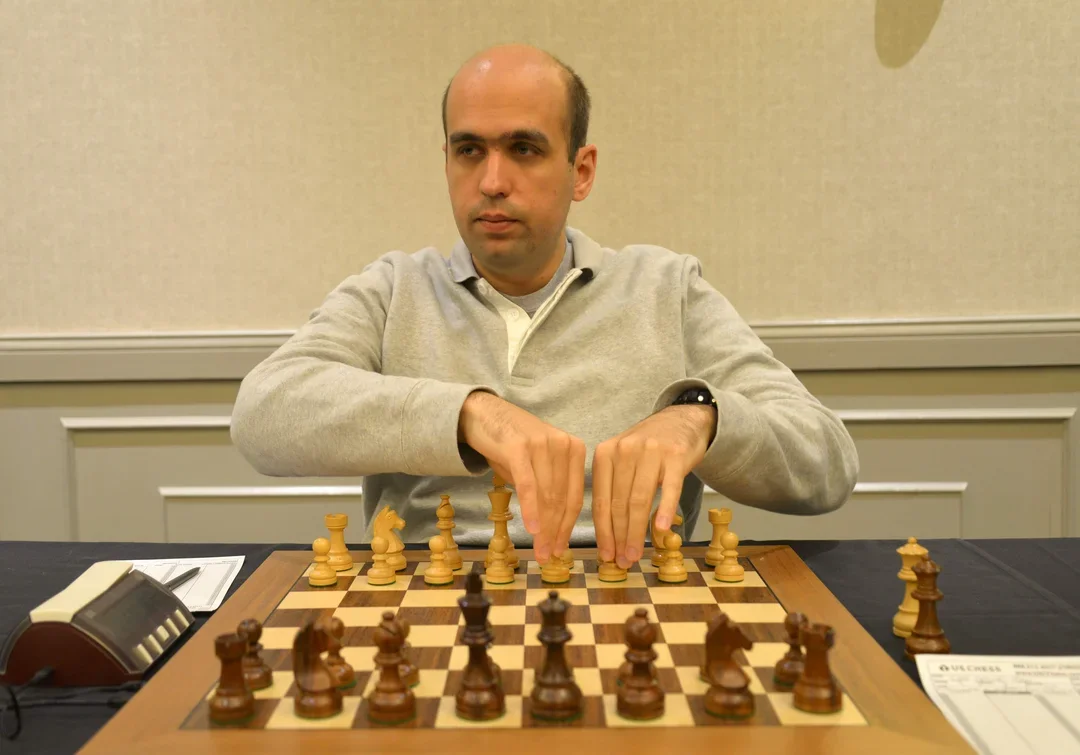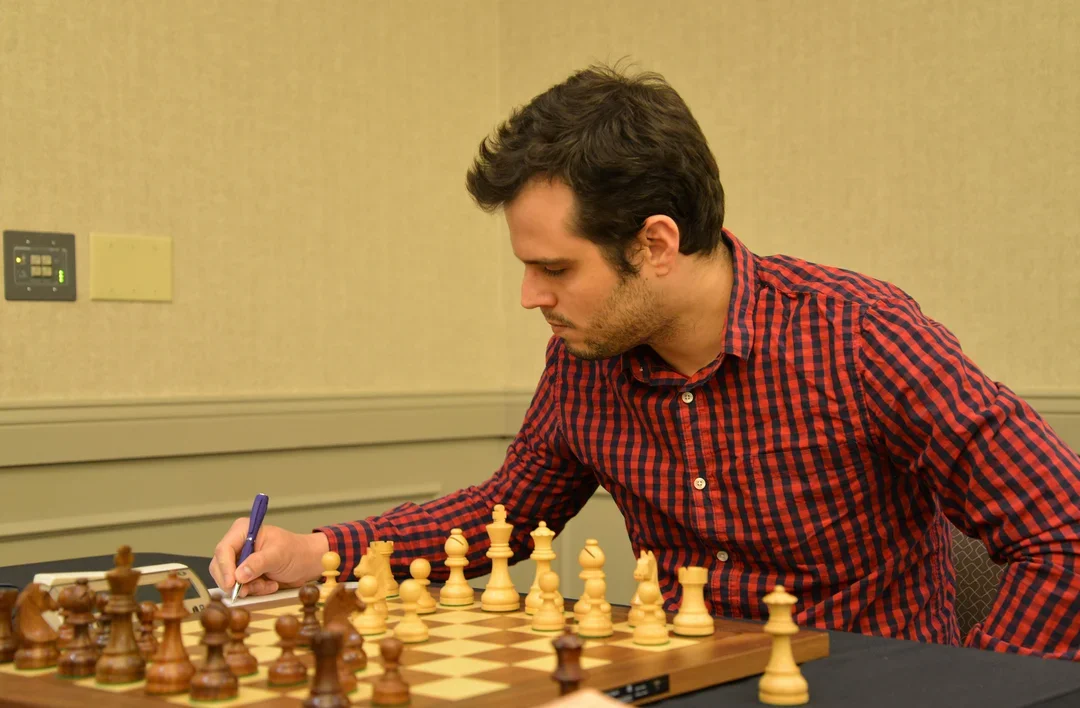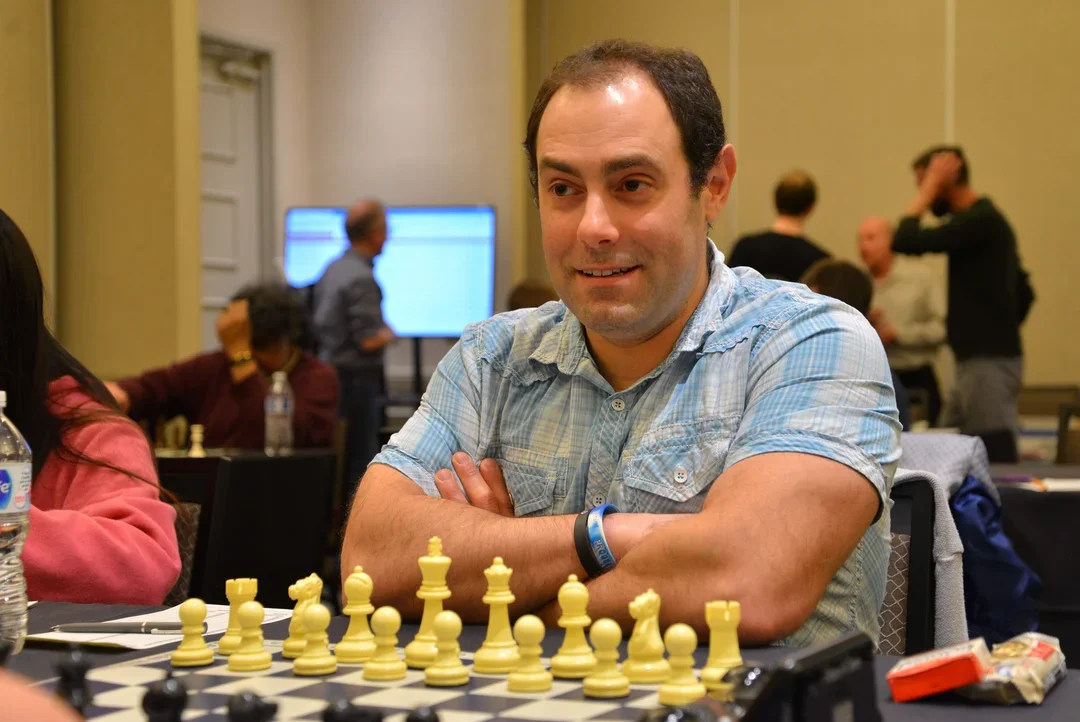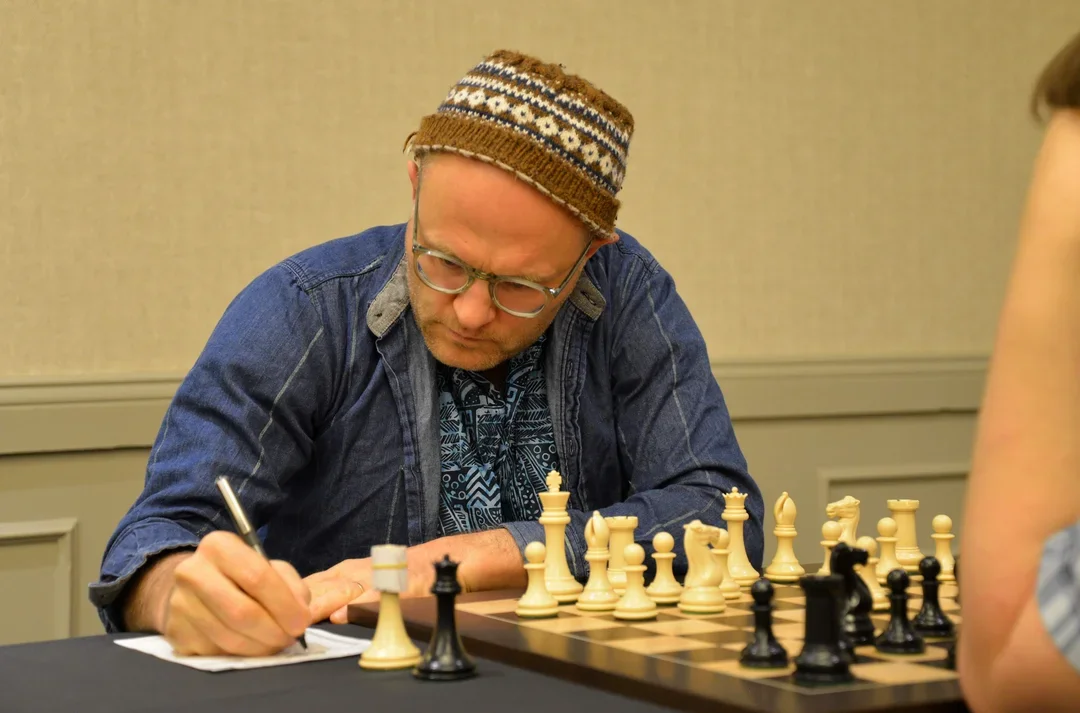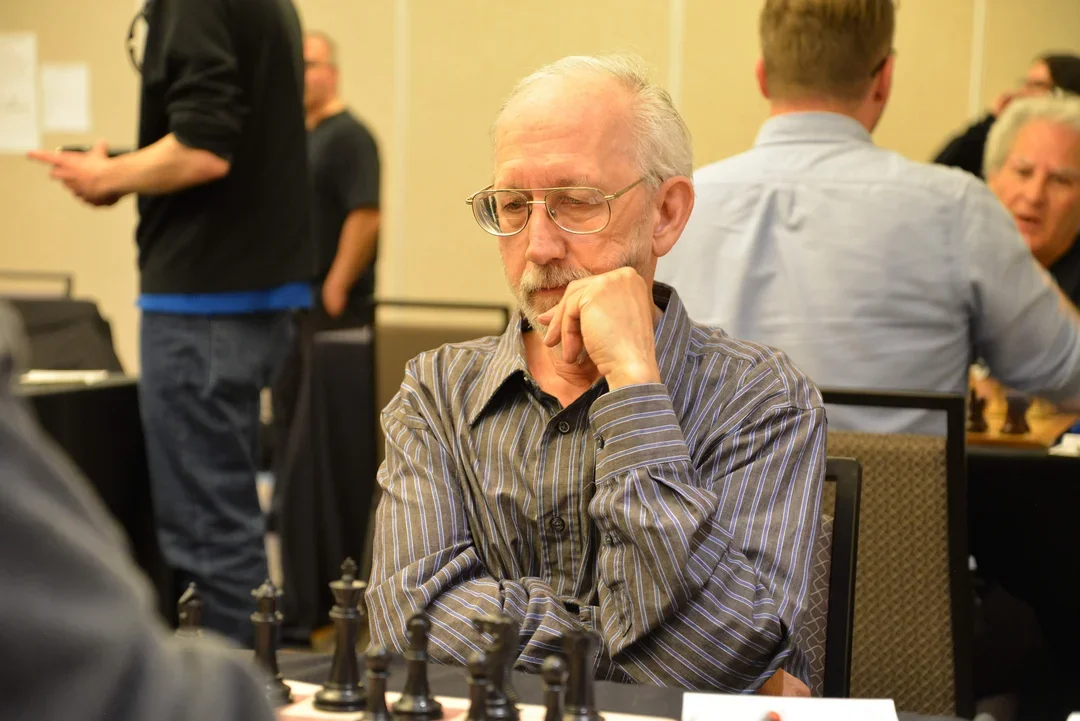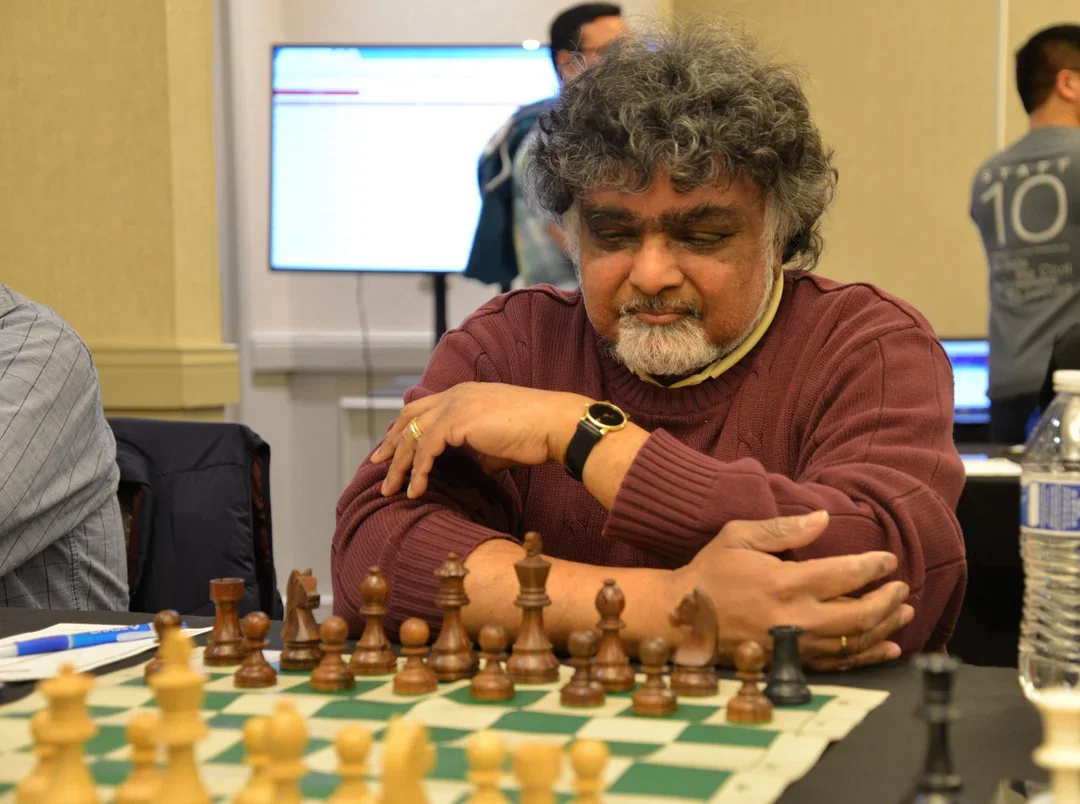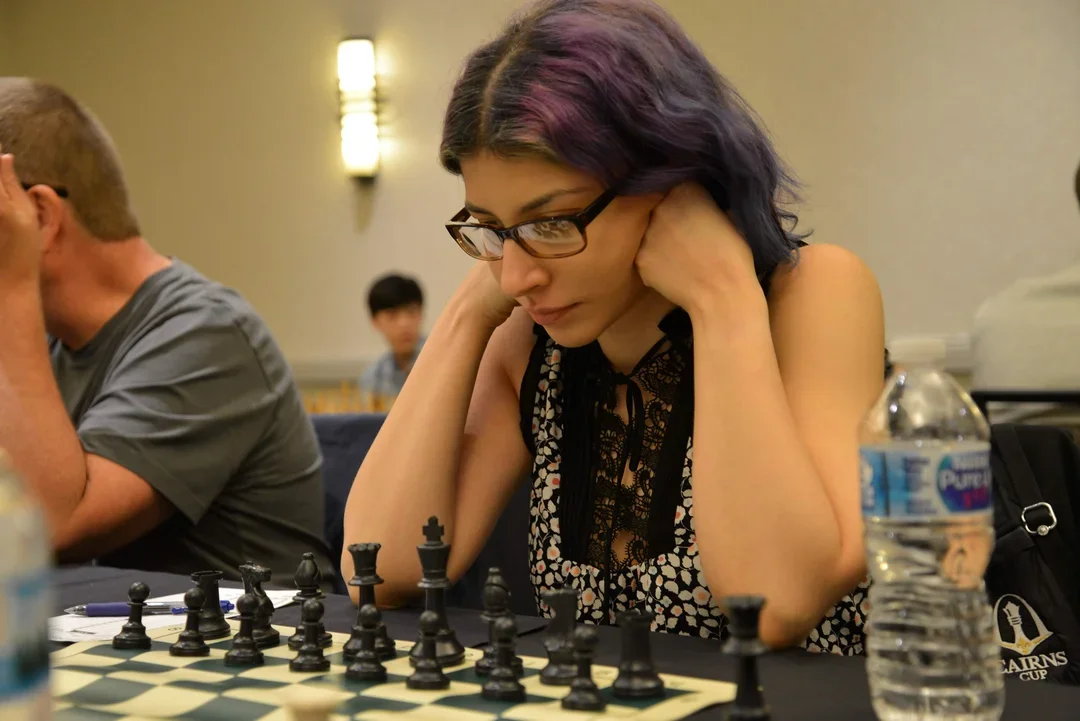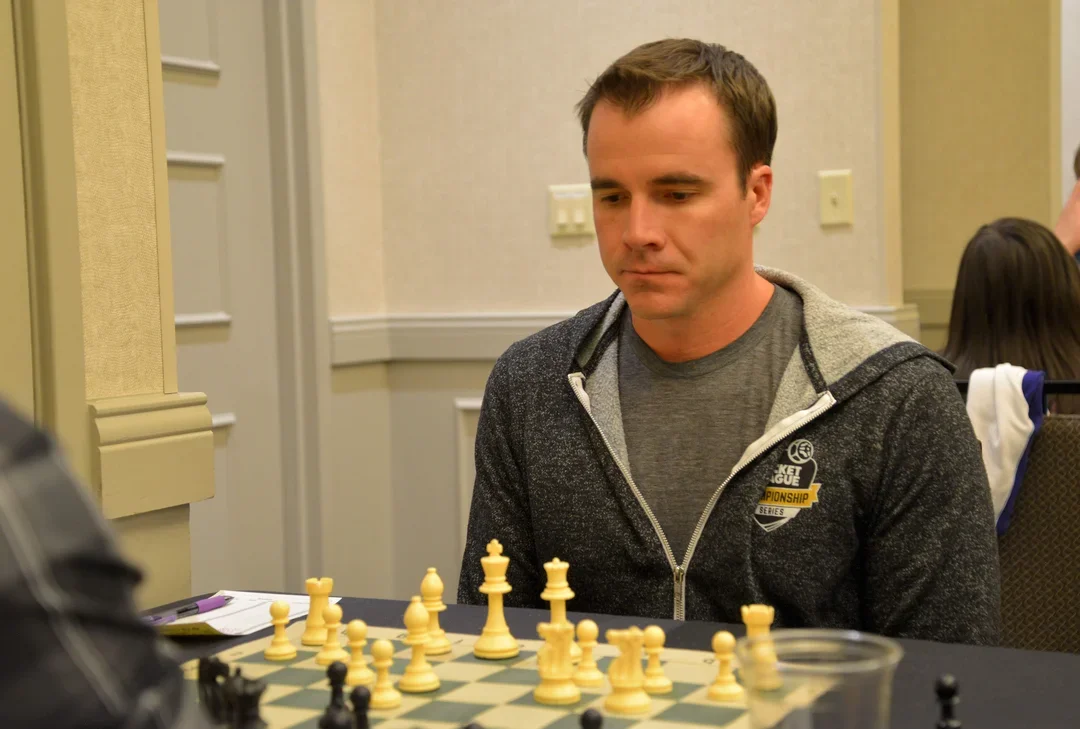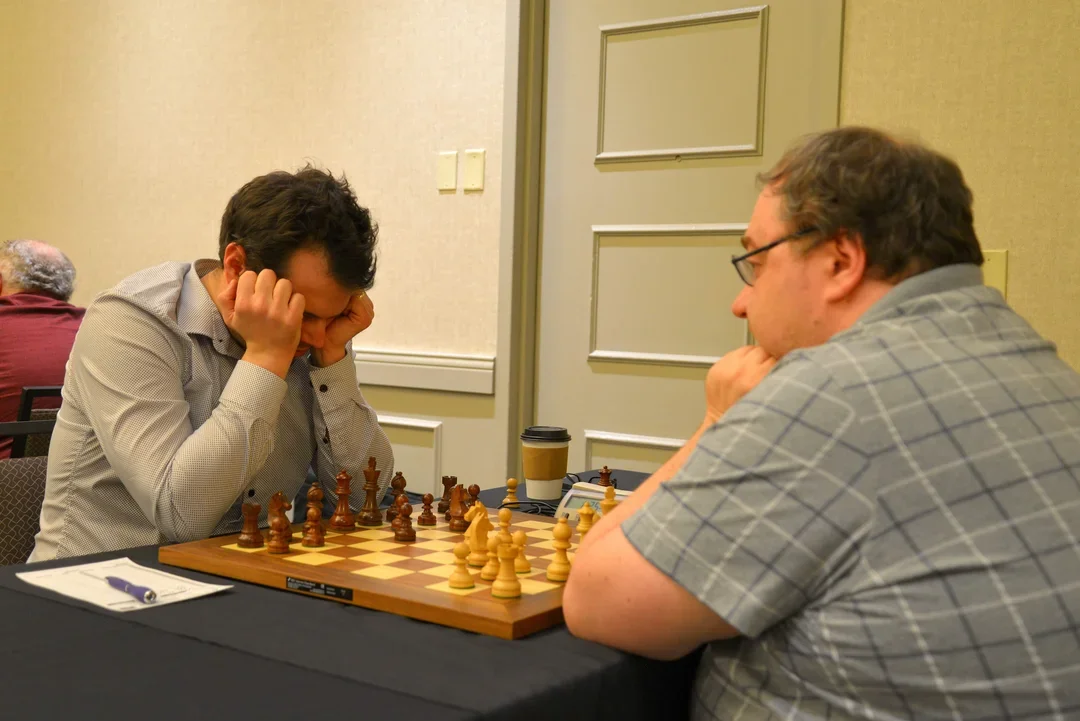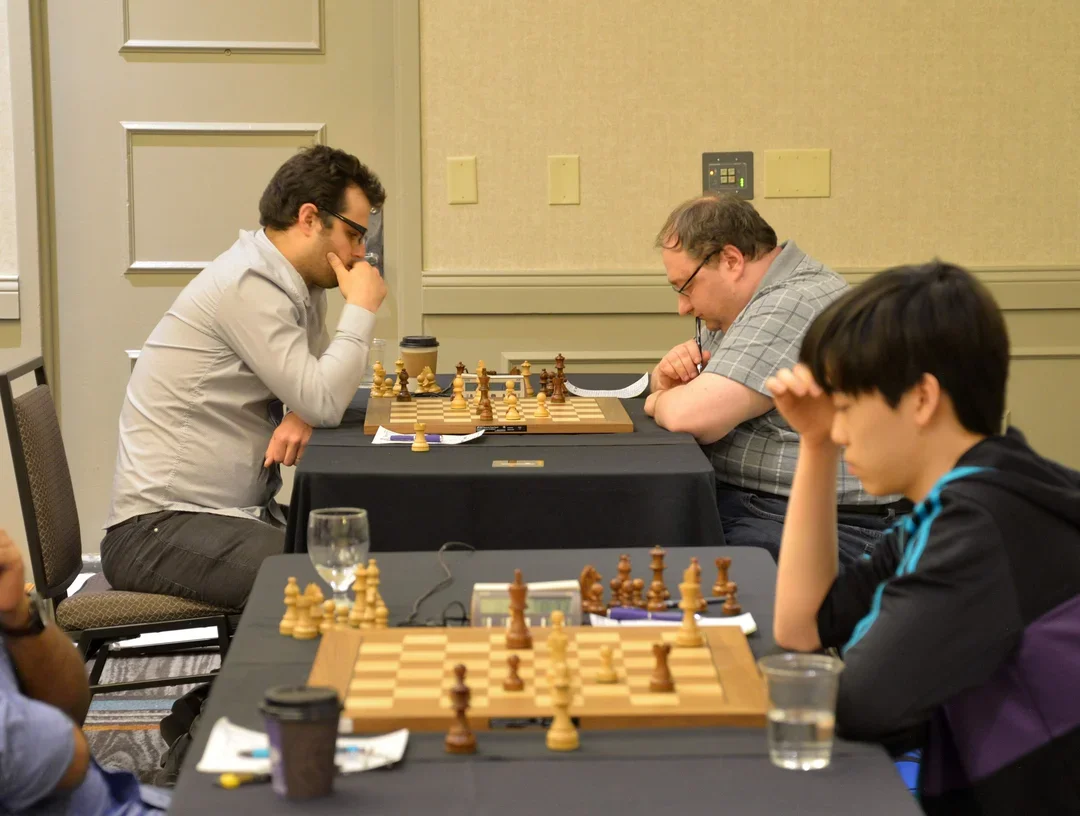Founded in 1859, the Denver Chess Club is one of the oldest chess clubs in the United States. This year a few enthusiastic club members got together and came up with the ambitious idea of inviting leading players and chess personalities to participate in the Denver Open, a tournament with a history going back to 1870. Club President Brian Wall, J C MacNeil, Kevin McConnell , and Ann Davies were among those who contributed considerable time and money, funding several side events to help make this the most significant Colorado tournament in many years. To kick off the festivities, IM Danny Rensch of chess.com fame lectured and gave a 26-board simultaneous exhibition.
Of particular interest was the Girls State Scholastic Tournament, sponsored by the Colorado State Chess Association and directed by Dean Clow and Todd Bardwick. It drew 46 players in three sections, with Tanya Olga Sorbana winning the 7-12 section, Tanishka Sameer Tagare the 4-6 section, and Tanya Prabhu Gurpur Madke the K-3. WGM Tatev Abrahamyan, who recently finished second in the US Women’s Championship, was the star guest of honor for this event.
The top section was headed by Grandmasters Fidel Corrales Jimenez, Andrey Gorovetz, Jesse Kraai, Alexander Fishbein, and Andrew Tang, along with IMs Danny Rensch, David Vigorito, Dean Ippolito, Prasanna Rao, WGM Tatev Abrahamyan, and numerous strong untitled players. Sunil Weeramantry was a celebrity addition; he is famous as a chess coach, trainer, author, raconteur, and longtime head of the National Scholastic Chess Foundation, as well as a feared player in his prime.
In the first round, a fascinating fight took place between Brian Wall and fellow Coloradan Jesse Hester.
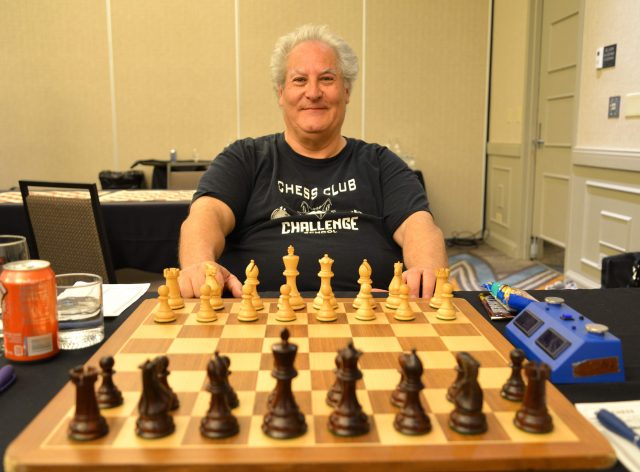 Brian Wall (photo John Brezina)
Brian Wall (photo John Brezina)Brian has not only been a dominant force in Colorado chess for almost 5 decades, he is nationally renowned for his writings, teaching, and advocacy of unusual openings. [Editor's note: Because IM Watson's annotations are so dense, we are alternatively providing them via the ChessBase replayer.]
[pgn] [Event "Denver Open 2019"] [Site "Denver USA"] [Date "2019.04.26"] [Round "1"] [White "Wall, Brian"] [Black "Hester, Jesse Randall"] [Result "1/2-1/2"] [ECO "B21"] [WhiteElo "2158"] [Annotator "John Watson"] [PlyCount "74"] [EventDate "2019.04.26"] [EventType "swiss"] [EventRounds "5"] [EventCountry "USA"] [Source "Mark Crowther"] [SourceVersion "1"] [SourceVersionDate "2019.05.06"] [SourceQuality "2"] 1. e4 c5 2. d4 {Brian Wall has never been shy! It's fun that this pawn sacrifice, called the 'Smith-Morra Gambit', is still playable in modern chess.} cxd4 3. c3 dxc3 4. Nxc3 Nc6 5. Nf3 d6 6. Bc4 a6 7. O-O Nf6 {For many years, this sequence has been considered Black's most reliable line versus the Morra Gambit. It achieved a certain prominence after Larry Evans and Mecking used it to beat Ken Smith (the 'Smith' in Smith-Morra) in San Antonio 1972.} 8. Bg5 { Given '?!' by Smith-Morra expert Langrock, even if White develops quickly. The most dangerous move is} (8. Bf4 $1 {, threatening 9 e5. A few sample lines:} Bg4 (8... e5 9. Ng5 $1 {leaves f7 hanging, and might lead to} exf4 10. Nxf7 Qd7 11. Nxh8 Ne5 12. Be2 Be7 $5 13. Rc1 Kf8 14. Nd5 Nxd5 15. Qxd5 Qe6 16. Bc4 $1 Nxc4 17. Rxc4 Qf6) 9. h3 Bxf3 (9... Bh5 10. g4 Bg6 11. e5 dxe5 12. Nxe5 $13) 10. Qxf3 e6 11. Rfd1 Qb8 (11... Qa5 {and}) (11... Qb6 {are also played here}) 12. Be2 $5 {(to prepare Qg3 without meeting ...Nh5 in reply)} Be7 13. Qg3 O-O 14. Bxd6 {regaining the pawn with equal play.}) 8... e6 9. Qe2 h6 10. Bh4 { Black stands well in any case, but the options look somewhat better:} (10. Bf4 $5 {has the idea} g5 11. e5 $1) ({and} 10. Be3 {preserves the bishop.}) 10... Be7 ({Here Black had the opportunity to eliminate a bishop and gain central control by} 10... g5 $1 11. Bg3 Nh5 12. Rad1 Nxg3 13. hxg3 g4 ({or} 13... Bg7) 14. Nd4 Ne5 {intending ...h5-h4.}) 11. Rfd1 Qc7 12. Rac1 O-O 13. Bb3 {White prepares to play Nd5.} Qb8 {Stepping out of a potential attack along the c-file. In fact, after} (13... Rd8 {,} 14. Nd5 $5 {may not be that effective due to} exd5 15. exd5 Nxd5 $1 16. Bxd5 Bxh4 17. Nxh4 Qe7 {and Black remains a pawn up, although White has some positional compensation.}) 14. Na4 {Eyeing b6. } (14. Nd5 $5 {is quite possible here, in view of} exd5 15. exd5 Ne5 (15... Nxd5 16. Bxd5 Bxh4 17. Nxh4 Bd7 18. Ng6 Re8 19. Qf3) 16. Nxe5 dxe5 17. d6 Bxd6 18. Bxf6 gxf6 19. Qh5 {(threatening Qg6+)} (19. Qd3 Kg7 20. Qg3+ Kh7 21. Qd3+ Kg7 22. Qg3+ $11) 19... Kg7 20. Rc3 {, when Black may just hold on with} e4 21. Rxd6 Qxd6 22. Rg3+ Qxg3 23. hxg3 b5 {, which is still unclear.}) 14... b5 $5 ( 14... Qc7 {is also possible.}) 15. Rxc6 bxa4 16. Bxa4 Bd7 17. e5 $1 { Maintaining the initiative.} (17. Rc4 Bb5 ({or} 17... Bxa4 18. Rxa4 Qb5) 18. Bxb5 axb5 19. Rcc1 Qb7 $1 {gives Black a little pressure, although} 20. Bxf6 Bxf6 21. Rxd6 Rxa2 22. e5 Be7 23. Rd3 {is roughly equal.}) 17... Nd5 $5 (17... Bxc6 18. Bxc6 (18. exf6 Bxa4 19. fxe7 Rc8 20. b3 Bd7 {leaves Black with a material advantage}) 18... dxe5 19. Bxa8 Qxa8 20. Nxe5 Rd8 {is balanced.}) 18. Rxd5 $1 {More fun than} (18. Rc4 Bb5 $11) 18... Bxh4 (18... Bxc6 19. Bxc6 Bxh4 20. Rd1 {wins material, e.g.,} Bd8 21. Bxa8 Qxa8 22. exd6) {Now White takes a wild chance, a bit crazy but in the spirit of the Smith-Morra:} 19. Rdxd6 $5 ( 19. Rd4 Be7 20. exd6 (20. Rc2 $11) 20... Bf6 {is equal at best.}) 19... Bxc6 20. Rxc6 Be7 21. Bc2 {White has a pawn for the exchange and plays for direct attack. Qe4 is the first idea.} Rc8 $5 (21... g6 $1 {is a good option, but it's hard to resist the c-file counter-tactics ...Rc8 brings, and perhaps Black feared an h4-h5 theme. A posssible continuation is} 22. Be4 (22. h4 Qxb2 $1 23. h5 Qc1+ 24. Kh2 Rac8 $1) 22... Ra7 23. Qc2 Kg7 24. g3 $15) 22. Qe4 g6 23. Rxe6 $1 {The point, which Brian had to see well in advance.} Rxc2 $5 { One of several tries:} ({(a)} 23... fxe6 24. Qxg6+ Kf8 {looks like it loses to} 25. Nd4 {, but Black has the miraculous} Bg5 $1 26. Nxe6+ Ke7 27. Nxg5 Rxc2 $1 {and there's no mate, only a draw:} 28. Qh7+ $1 (28. Qe6+ Kd8 29. Qd5+ Kc7 30. Qf7+ Kb6 31. Qb3+ Ka7 32. Qxc2 hxg5 33. Qc5+ {is not so clear}) (28. Qf7+ Kd8 29. Ne6+ $2 Kc8 {and Black escapes}) 28... Ke8 $1 (28... Kd8 29. Ne6+ Ke8 30. Qxc2 $1 Qxe5 31. Qc6+ Kf7 32. g3 $1 {and White has all the chances}) 29. Qh8+ Kd7 30. Qh7+ Ke8 31. Qh8+ $11) ({(b)} 23... Bf8 24. Rxg6+ fxg6 25. Qxg6+ Bg7 26. Qh7+ Kf8 (26... Kf7 27. e6+ $5) 27. Qf5+ $11 Ke7 28. Qh7 $1 Rg8 29. Bb3) ({ (c)} 23... Kf8 $1 {is the best (and hard-to-find) solution, when Black stands objectively better but White still has practical chances in a real game. For example,} 24. Rxe7 (24. Rxg6 $5 fxg6 ({A pretty line is} 24... Qxb2 $4 25. Rg8+ $1 Kxg8 26. Qh7+ Kf8 27. Qh8#) 25. Qxg6 Rxc2 26. Qxh6+ Ke8 27. Qg6+ Kd8 28. Qxc2 {give White 5 pawns for a rook! Objectively Black stands better but it's a game}) 24... Kxe7 25. g3 Qxb2 26. Bb3 Rab8 27. Nd4 (27. e6 $5 Kf8 $2 28. Ne5 $1)) 24. Qxc2 fxe6 25. Qxg6+ Kf8 26. Nd4 {Threatening mate in one!} Bg5 27. Qe4 $5 {Still taking chances.} (27. Nxe6+ Ke7 28. Nd4 $1 Kf8 29. Ne6+ Ke7 30. Nd4 $11) 27... Qc8 28. g3 $1 Rb8 29. h4 (29. Qh7 $1 {is more accurate.}) 29... Bd2 (29... Be7 30. Qh7 Qc1+ 31. Kh2 Qc4 $1 {at first even seems to favor Black in view of} 32. Qh8+ Kf7 33. Qh7+ (33. Qxb8 $2 Qxd4) 33... Ke8 34. Qg8+ Kd7 35. Qxb8 Qxd4 {, but} 36. Qb7+ Ke8 37. Kg2 {should hold.}) 30. Qh7 Qe8 31. Nxe6+ ({ or} 31. Qh8+ Ke7 32. Qg7+ Kd8 33. Qa7 Rxb2 34. Nxe6+ Qxe6 35. Qd4+ Ke7 36. Qxb2 $11) 31... Qxe6 32. Qh8+ Qg8 33. Qf6+ Ke8 34. Qc6+ Kf7 35. Qf6+ Ke8 36. Qc6+ Kf7 37. Qf6+ Ke8 {Well-played by both players: a 19th-century masterpiece!} 1/2-1/2 [/pgn]
A game which ultimately proved important for the tournament was Jesse Kraai’s win over Daniel Herman, because the promising young local achieved a winning position versus his GM opponent (rated 500 points higher). Kraai’s escape enabled him to stay in contention for and eventually succeed in grabbing the top prize. [pgn] [Event "Denver Open 2019"] [Site "Denver USA"] [Date "2019.04.26"] [Round "1"] [White "Kraai, Jesse"] [Black "Herman, Daniel"] [Result "1-0"] [ECO "A46"] [WhiteElo "2484"] [BlackElo "1911"] [Annotator "John Watson"] [PlyCount "94"] [EventDate "2019.04.26"] [EventType "swiss"] [EventRounds "5"] [EventCountry "USA"] [Source "Mark Crowther"] [SourceVersion "1"] [SourceVersionDate "2019.05.06"] [SourceQuality "2"] 1. d4 Nf6 2. Nf3 e6 3. g3 b5 {This move has become extremely popular over the past few years.} 4. Bg2 Bb7 5. O-O c5 6. Bg5 (6. c3 {is most often-played here. }) 6... Be7 (6... d5 {and}) (6... cxd4 {are alternatives.}) 7. dxc5 Bxc5 8. Qd3 a6 9. Nbd2 (9. a4 {and}) (9. c4 {have both been tried here.}) 9... O-O 10. a4 b4 11. c4 bxc3 12. Qxc3 Be7 13. Rfc1 $6 h6 (13... Nd5 14. Qb3 (14. Bxe7 $4 Nxc3 15. Bxd8 Nxe2+) 14... Nc6 $1 {equalizes:} 15. Bxe7 Qxe7 16. Nc4 (16. Qxb7 $2 Rfb8) 16... Ndb4 $11) 14. Be3 Nc6 (14... Nd5 $1 15. Qb3 Nc6 $1 $15) 15. Qb3 Rb8 $6 (15... Nd5 $1 {looks fully equal, since} 16. Qxb7 $2 Na5 17. Bb6 Nxb6 18. Qe4 d5 19. Qd3 Rb8 {pus pressure on White's queenside.}) 16. Bb6 $1 Qc8 17. Ne5 d5 $5 18. Ba7 $6 (18. Ndf3 $1 $16) 18... Ra8 19. Be3 Nd7 20. Nd3 Qb8 21. Nf3 Na5 22. Qc3 Nc4 23. Bf4 $6 (23. Bd4 $1 {controls e5 and prepares b3.}) 23... Qa7 24. Nfe5 $2 {Walking into a pin which proves very difficult to break.} ({ Now d4 is less well-defended, so} 24. b3 {can be answered by} Bf6 {Then the exchange sacrifice} 25. Qe1 Bxa1 26. Rxa1 {would be quite promising if Black couldn't counter with} e5 $1 27. Ndxe5 Ncxe5 28. Nxe5 Rfd8 {, when White has some but perhaps not quite enough compensation.}) 24... Bf6 {The pin is terribly awkward and White is probably already lost.} 25. b3 (25. e3 {doesn't really help because Black has} g5 $1 {, and if} 26. Qd4 {,} Rfd8 $1 27. Qxa7 Rxa7 28. Nxd7 Rxd7 {will still win material.}) (25. h4 $2 Ndxe5 26. Nxe5 Rac8 { wins on the spot.}) 25... Ncxe5 26. Bxe5 (26. Nxe5 $2 Rfc8 27. Qb2 Rxc1+ 28. Rxc1 Qb8 $1 {and Black wins material.}) 26... Nxe5 27. Nxe5 {At this point White offered a draw. Facing an opponent rated 500 points higher, Black bravely and correctly refused, but did so with a move that largely lets his opponent off the hook:} d4 $2 (27... Rac8 28. Qb2 a5 $1 $17 {and White is stuck. There might follow} 29. e3 Ba6 30. Bf1 Bxf1 31. Kxf1 Qb6 {with a huge advantage} ({or} 31... Rb8)) 28. Qc5 Bxg2 29. Kxg2 Bxe5 $6 ({Black could still maintain a small edge with} 29... d3 $1 30. exd3 Qb7+ 31. Kh3 Rfc8 32. Qe3 Bxe5 33. Qxe5 Qxb3 $15) (29... Qb7+ 30. Qc6 Qxb3 31. Nd7 {is unclear.}) 30. Qxe5 Qb7+ 31. Kg1 Qxb3 ({Or} 31... Rad8 $11) 32. Qxd4 Rfd8 33. Qf4 Rac8 34. a5 Rxc1+ 35. Qxc1 Qd5 36. Qc7 Qd7 37. Qb6 Qc8 38. Rb1 Rd5 39. Qa7 $6 {Ambitious but risky.} Rd7 $2 {This leads to a passive rook ending.} (39... Qc6 $1 {threatens ...Rxa5, when} 40. e4 $5 (40. f3 g6 $15) 40... Rxa5 (40... Rd7) 41. Rb8+ Kh7 42. Qxf7 Ra1+ 43. Kg2 Qxe4+ 44. Kh3 Qf5+ 45. Qxf5+ exf5 46. Rb6 {will hold.}) 40. Qb8 Qxb8 41. Rxb8+ Kh7 42. Rb6 Rd2 {Black tries to stay active.} (42... Ra7 {is a negative-looking move which nevertheless should probably hold in the long run.}) 43. e3 Ra2 44. Rxa6 Kg6 (44... h5 {and}) (44... g5 {are better ideas, because later Black wants to exchange some kingside pawns.}) 45. Kg2 Kf5 $6 (45... h5) 46. Ra7 f6 $2 {An oversight.} (46... Kf6) 47. Rxg7 Rxa5 ({ Blaack resigns in view of} 47... Rxa5 48. g4+ Ke4 (48... Ke5 49. Rh7) 49. Rg6 $18 {, when the extra two pawns will be relatively easy to convert.}) 1-0 [/pgn]
In round three, two of the favorites met in the game Fishbein-Corrales Jimenez. White played a tricky positional setup versus the Sicilian and achieved a nice edge, sacrificing the exchange to achieve a strong bind. But after some inaccuracies Black cleverly achieved active counterplay and took over:
[pgn] [Event "Denver Open 2019"] [Site "Denver USA"] [Date "2019.04.27"] [Round "3"] [White "Fishbein, Alex"] [Black "Corrales Jimenez, Fidel"] [Result "0-1"] [ECO "B58"] [WhiteElo "2456"] [BlackElo "2563"] [Annotator "John Watson"] [PlyCount "120"] [EventDate "2019.04.26"] [EventType "swiss"] [EventRounds "5"] [EventCountry "USA"] [Source "Mark Crowther"] [SourceVersion "1"] [SourceVersionDate "2019.05.06"] [SourceQuality "2"] 1. e4 c5 2. Nf3 d6 3. d4 cxd4 4. Nxd4 Nf6 5. Nc3 Nc6 6. Be2 e5 7. Nf3 h6 8. O-O Be7 9. Re1 O-O 10. h3 a6 $5 {I don't like this plan much.} (10... Be6 {is more thematic, challenging d5, e.g.,} 11. Bf1 Qa5 (11... Rc8 12. Nd5 Na5 $5) 12. a3 (12. Bd2 Qd8 13. Bc1 (13. a4 d5) 13... Qa5 14. Bd2 Qd8 15. Bc1 {Svidler,P (2630)-Khalifman,A (2650) Yerevan 1996}) 12... Rfc8 13. Rb1 (13. Be3) 13... Nb8 $5 14. Nh4 Nc6 15. Nf3 (15. Nf5 $2 Bxf5 16. exf5 d5) 15... Nb8 16. Nh4 Nc6 17. Nf3 Nb8 {½-½ Smeets,J (2538)-Nijboer,F (2638) Wijk aan Zee 2007}) 11. Bf1 b5 12. a4 $1 b4 13. Nd5 {This position has arisen frequently over the years, with excellent results for White.} a5 (13... Rb8 14. Bc4 a5 $6 (14... Na5 15. Nxf6+ Bxf6 16. Bd5 Be6) 15. Qd3 Nxd5 16. Bxd5 $14 {Kostrikina,A (2157)-Lastin,A (2504) Dombai 2013}) (13... Nxd5 14. exd5 Na5 (14... Nb8 15. a5 $1) 15. Bd2 Rb8 16. Re4 b3 17. c3 $14) 14. Bc4 Be6 15. Qd3 ({The still more accurate} 15. Be3 $1 {targets b6:} Bxd5 (15... Rb8 16. Bb5 $16) (15... Nb8 16. Nxf6+ Bxf6 17. Bd5 Bxd5 18. Qxd5) 16. exd5 $1 Nb8 17. Bb5 $16) 15... Bxd5 16. exd5 $1 {A nice decision, giving up the exchange.} (16. Bxd5 Nxd5 17. Qxd5 Qc7 18. Be3 { looks nice for White, but Black is solid.}) 16... e4 $5 {Black takes the material, trying to avoid positionally disastrous lines such as} (16... Nb8 17. Nd2 Nbd7 18. Nb3 Qc7 19. Bb5 $1 Rac8 (19... Rfc8 20. Bc6) 20. Be3 $1 Qxc2 21. Qxc2 Rxc2 22. Nxa5 Rxb2 23. Nc6 Bd8 24. Bc1 Rb3 25. a5 $16) 17. Rxe4 Nxe4 18. dxc6 {But now White has a passed pawn, two bishops, and enemy weaknesses in return for the exchange.} Nf6 $6 (18... Nc5 19. Qd5 Bf6 {is preferable.}) 19. Nd4 $5 (19. Bf4 $1 $16 {is primitive and strong, e.g.,} Qb6 (19... d5 20. c7) 20. Bb5 d5 21. Be5 {with Bd4 next.}) 19... d5 20. Ba6 $5 (20. Bb5 Bd6 $14) 20... Ne4 $1 {threatening ...Nc5.} 21. Bb7 Rb8 {Black has sufficient counterplay.} 22. Nb5 Bc5 23. Be3 Qb6 24. Qxd5 $2 {This works out badly. White should be patient with} (24. Rd1 {, when} Rfe8 25. Bd4 $11 {might follow.}) 24... Bxe3 25. Qxe4 Bxf2+ 26. Kh1 Rbe8 (26... Bg3 $1 $17) 27. Qc4 $6 (27. Qf4) 27... Bg3 28. Qd4 {White is clearly in trouble now and chooses the endgame, hoping that the opposite-colored bishops will give drawing chances.} Qxd4 29. Nxd4 g6 30. Ba6 Re4 31. Ne2 Bc7 32. Rd1 Rd8 33. Rxd8+ Bxd8 34. g3 Kf8 35. Kg2 Bb6 36. b3 {White can only sit around.} Ke7 37. Nf4 Kd6 38. Bc4 {Trying to force matters, in view of lines like} (38. Bb5 g5 39. Ne2 f5 40. Kf3 Re3+ 41. Kg2 Kd5 42. Kh2 Ke5 43. Kg2 f4 $19) 38... g5 39. Nh5 Bd4 40. g4 Be5 41. Kf3 Re1 42. Bb5 Rc1 43. Bc4 Rxc2 44. Bxf7 Rxc6 45. Ke4 Rc7 46. Bg8 Rc3 47. Kf5 Rxh3 48. Kg6 Rh4 49. Kf5 Rh2 50. Kg6 Rg2 51. Kf5 Bh8 52. Bc4 Kc5 53. Be6 Kd4 54. Kg6 ({ White will run out of room after} 54. Bg8 Rc2 55. Kg6 Rc6+ 56. Kf5 Rc8 {, e.g., } 57. Be6 Rc5+ 58. Kg6 Rc6 59. Kf5 Rxe6 $1 60. Kxe6 Kc3) 54... Ke5 55. Bf5 Rb2 56. Ng3 Rxb3 57. Ne4 Rh3 58. Nc5 Rc3 59. Nb7 Rc6+ 60. Kh5 Kf6 $1 (60... Kf6 61. Kxh6 (61. Nxa5 Rc3 {mates}) 61... Bg7+ 62. Kh7 b3 {and the pawn advances.}) 0-1 [/pgn]
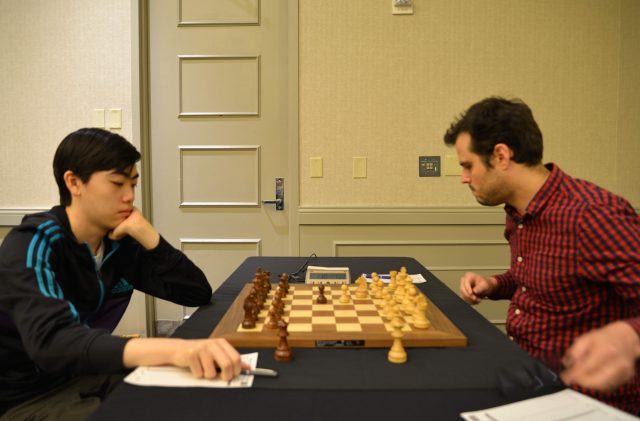 Corrales Jimenez-Tang
Corrales Jimenez-TangThe Corrales Jimenez-Tang 4th-round grandmaster matchup was a wild, difficult affair from start to finish.
[pgn] [Event "Denver Open 2019"] [Site "Denver USA"] [Date "2019.04.28"] [Round "4"] [White "Corrales Jimenez, Fidel"] [Black "Tang, Andrew"] [Result "1/2-1/2"] [ECO "C45"] [WhiteElo "2563"] [BlackElo "2501"] [Annotator "John Watson"] [PlyCount "94"] [EventDate "2019.04.26"] [EventType "swiss"] [EventRounds "5"] [EventCountry "USA"] [Source "Mark Crowther"] [SourceVersion "1"] [SourceVersionDate "2019.05.06"] [SourceQuality "2"] 1. e4 e5 2. Nf3 Nc6 3. d4 exd4 4. Nxd4 Nf6 5. Nxc6 bxc6 6. e5 Qe7 7. Qe2 Nd5 8. c4 Nb6 9. Nc3 Bb7 10. b3 $5 {This is rarely-played but has not been considered bad. The most popular continuation is} (10. Bd2 O-O-O 11. O-O-O) 10... O-O-O 11. Bb2 Re8 12. f4 ({With hindsight, sacrificing a pawn by} 12. O-O-O Qxe5 13. Qxe5 Rxe5 14. Bd3 {might have been a better practical choice. White has enough compensation, but no more.}) 12... g5 $1 (12... f6 {has been the normal response here, but this g-pawn thrust seems very effective, destroying White's center.}) 13. Ne4 $1 ({The only other game I see here went well for Black:} 13. fxg5 $6 Qxg5 14. Ne4 Bb4+ (14... Qg6 $1 15. Nf6 Re6 $17) (14... Qh6) 15. Nd2 $6 (15. Kd1 Qg6 $15) 15... f6 16. O-O-O fxe5 $17 {Lafer,D (1694)-Atzl,F (2026) St Veit 2017}) 13... Bg7 ({The exchange sacrifice} 13... gxf4 14. Nf6 Bh6 $5 { is also interesting.}) 14. Nxg5 (14. g3 {is a decent option. Black might try} Rhg8 {, e.g.,} 15. O-O-O (15. Nxg5 f6 16. Nf3 fxe5 17. fxe5 Qb4+) 15... gxf4 16. gxf4 Qh4 $1) 14... f6 15. Nf3 fxe5 ({Another good course was} 15... c5 $5 16. O-O-O Bh6) 16. fxe5 Bh6 $5 (16... c5 $1) 17. Qd3 $5 ({Or} 17. Qf2 Rhf8 ( 17... c5 18. Bd3 Rhf8 19. O-O $14) 18. Bd3 Qb4+ 19. Kd1 {, when} d5 $1 20. Qe1 $1 Qe7 21. c5 $1 Qxc5 22. Bd4 {is dynamic and unclear.}) 17... Rhg8 $5 (17... c5 $1 {would prevent White's next move.}) 18. g3 $1 d5 (18... c5 19. Bg2 $16) 19. Be2 $6 (19. Bh3+ $1 Kb8 20. O-O $14) 19... Rd8 ({Here} 19... c5 $1 { keeps the initiative. Andrew probably underestimated White's next:}) 20. c5 $1 {Simple but ingenious.} Qxc5 21. Nd4 {In return for the pawn, all of White's pieces are coordinating, with control of the light squares and his rooks about to become active.} Rdf8 (21... Rge8 22. O-O Rxe5 23. Kh1 $1 {is easy to play for White.}) 22. Nf5 $5 (22. a3 {with the idea b4 is also good.}) 22... Bg5 $2 {A plausible move covering key squares, but White has too much pressure.} ( 22... Rxf5 23. Qxf5+ Kb8 $14 {gives Black considerable compensation, with ... Rf8 and ...Be3 in the air, and is better than anything slower.}) 23. h4 { Logical and good, but White had even better.} ({The slow} 23. a3 $1 {was a difficult move to find: it takes away squares from Black's queen and virtually forces} d4 24. Bxd4 Qd5 {, when} 25. O-O $16 c5 26. Bf3 Qd7 27. e6 $1 Qxe6 28. Bxc5 $16 {clearly favors White.}) 23... Bd8 24. Rf1 Kb8 25. Rc1 {A good move, but} (25. a3 $1 {would have tied Black down still further, presumably forcing} Ba6 (25... Bc8 26. Bd4 $1 Bxf5 27. Bxc5 Bxd3 28. Rxf8 Rxf8 29. Bxf8 $18) 26. Qxa6 Rxf5 27. Rxf5 Qc2 28. Qd3 Qxb2 29. Rd1 $16) 25... Qb4+ $1 {Black scrapes up some active play.} 26. Qc3 Qe4 27. Rf4 Qh1+ 28. Kd2 Qh2 29. Rcf1 Rxf5 $1 30. Rxf5 Rxg3 31. Qd4 Bxh4 32. R1f2 (32. e6 $1) 32... Bg5+ $4 {The problems posed on every move are having their effect, and time pressure is undoubtedly becoming a factor. Black should have tried} (32... Qh1 $1 {, and only after} 33. Rf1 Qh2 34. R5f2 {would} (34. e6 $5) 34... Bg5+ {be correct, limiting White's advantage.}) 33. Rxg5 Qh6 34. Qf4 $1 Rxg5 (34... Qxg5 35. Qxg5 Rxg5 36. e6 {and the e-pawn can't be stopped.}) 35. e6 $5 (35. Qf8+ $1 Qxf8 36. Rxf8+ Nc8 37. e6 {wins straight away. If} Rg2 (37... Rg6 38. e7 Re6 39. e8=Q) 38. e7 Ba6 39. e8=Q Rxe2+ 40. Qxe2 Bxe2 41. Kxe2 {leaves White a rook up. Who knows what Corralles Jiminez, who has played such a fabulous game, missed here? Probably he saw that 35 e6 would win and didn't look at the easier line. Now in time pressure Tang manages to pull off a miracle defense:}) 35... Nc8 36. Bf6 $5 (36. Be5 $1 {and}) (36. e7 $5 Nxe7 37. Bf6 {are also good, and simpler to play.}) 36... Rg6 37. Qxh6 Rxh6 38. e7 Rxf6 $1 39. Rxf6 (39. e8=Q Rxf2 { gives Black plenty of material and at least equality.}) 39... Nxe7 40. Rf7 $2 { The 40th move! With time to think, he wuld see that} (40. Rf8+ $1 {keeps Black tied down completely:} Bc8 (40... Nc8 41. b4 h5 42. Bd3 h4 43. Bf5) 41. Ba6 h5 42. b4 h4 43. Ke2 h3 44. Kf2 d4 45. Re8 d3 46. Bxd3 $18) 40... Ng6 $5 {Black's 40th.} (40... Nc8 $1 {looks more accurate, and may well be drawing, since} 41. Rxh7 (41. Rf8 a5 $1) (41. b4 $1 {is the best chance}) 41... a5 42. Ke3 Nd6 { covers all the key squares.}) 41. Rxh7 (41. b4 $5) 41... a5 42. Rg7 ({Another try was} 42. Bh5 Nf4 43. Bf7 {, which prepares Rh4 and forces the knight to an awkward square.}) 42... Nf4 43. Bg4 Ba6 (43... c5 $5) 44. Bf5 (44. Bd7 $1 Kb7 45. Rg8) 44... Kb7 45. Rg4 Nh5 (45... Ne2) 46. Rg6 Nf4 47. Rh6 Ne2 $1 {The miracle is complete.} ({There might follow} 47... Ne2 48. Bd7 Nd4 49. Ke3 Nc2+ 50. Kf4 Nd4 51. Ke5 Nf3+ 52. Kf4 Nd4 {, etc. Considering the many extremely difficult decisions both players had to make, this was a high-quality fighting game.}) 1/2-1/2 [/pgn]
Josh Bloomer was the star player for Colorado, finishing with a stunning 2626 performance rating, and gaining a whopping 103 FIDE rating points. He lost only once, to Tatev Abrahamyan, a game in which he had a winning position for many moves but couldn’t seem to pull the trigger and eventually blundered. After that, he absolutely decimated this writer in a miniature, won a terrifically hard-fought tactical battle against IM Rao, and in the last round won the following crucial game to secure a 4-1 result and tie for 3rd-6th place:
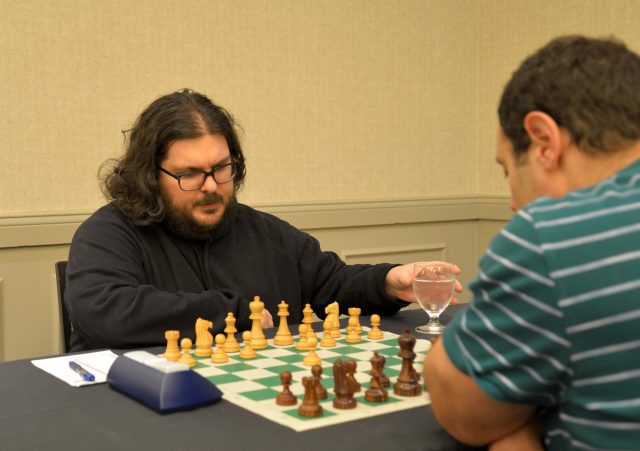 Bloomer-Ippolito
Bloomer-Ippolito[pgn] [Event "Denver Open 2019"] [Site "Denver USA"] [Date "2019.04.28"] [Round "5"] [White "Bloomer, Josh"] [Black "Ippolito, Dean"] [Result "1-0"] [ECO "B99"] [WhiteElo "1950"] [BlackElo "2339"] [Annotator "John Watson"] [PlyCount "41"] [EventDate "2019.04.26"] [EventType "swiss"] [EventRounds "5"] [EventCountry "USA"] [Source "Mark Crowther"] [SourceVersion "1"] [SourceVersionDate "2019.05.06"] [SourceQuality "2"] 1. e4 c5 2. Nf3 d6 3. d4 cxd4 4. Nxd4 Nf6 5. Nc3 a6 6. Bg5 e6 7. f4 Be7 8. Qf3 Qc7 9. O-O-O Nbd7 10. g4 b5 11. Bxf6 Nxf6 12. g5 Nd7 13. f5 {A position which has arisen thousands of times in master play.} O-O ({Over the years,} 13... Bxg5+ {and}) (13... Nc5 {have been played the most, but in the past few years 13...0-0 has become as frequent a choice as 13...Bxg5+, while 13...Nc5 is seen a lot less.}) 14. Rg1 {A couple of known options played this year:} (14. fxe6 fxe6 (14... Bxg5+ 15. Kb1 Nb6 16. Nd5 $14) 15. Nxe6 (15. Qg3 Nc5) 15... Rxf3 16. Nxc7 Bxg5+ ({or} 16... Ra7 17. Ne8 $5 Ne5 18. Nxd6 Bg4) 17. Kb1 Rb8 18. Ne8 Nb6 (18... Nc5 19. Nxd6 Be6 $11) 19. Rg1 (19. Nxd6) 19... Bf6 (19... Be3 $1 20. Rxg7+ Kf8 $13) 20. Rd3 Rxd3 21. Nxf6+ Kf7 22. Bxd3 gxf6 23. Ne2 {with a small edge, Divya,D (2266)-Bach,N (2117) Ho Chi Minh City 2019}) (14. f6 gxf6 15. gxf6 Nxf6 $15 16. Bd3 $2 (16. e5 $1 dxe5 17. Nc6 Bb7 18. Qg3+ Kh8 19. Nxe5 Bd8 20. Rxd8 Raxd8 21. Ng6+ hxg6 22. Qxc7 Bxh1) 16... Kh8 17. Rhf1 Rb8 (17... b4 18. Nce2 Bb7) 18. e5 dxe5 19. Qh3 e4 20. Rxf6 exd3 21. Rh6 Bg5+ 22. Kb1 dxc2+ 23. Nxc2 f5 $19 {0-1 Ross,S (1630)-Ratnesan,R (2115) Coventry 2019}) 14... b4 15. Nce2 Kh8 $2 {Was this an intentional novelty, designed to confuse White? If so, Ippolito is making a brave but unlucky choice. Perhaps he was unaware that Josh's 1900 FIDE rating bore no resemblance to his playing strength.} ( 15... e5 $1 {has been played in scores of games and scores decently, although Black generally draws and seldom wins. Recent examples:} 16. f6 exd4 17. fxe7 Re8 18. Nxd4 Ne5 19. Qf2 (19. Qf4 {has been more common, but Black seems to have few problems after} Be6 20. Kb1 Rxe7 21. h4 Qc5 22. Rg2 a5) 19... Be6 20. Kb1 Qc5 (20... Rxe7) 21. Rg2 Rxe7 22. h4 a5 23. Nxe6 fxe6 24. Qd2 Rf8 25. Be2 Rd7 (25... Ref7 $5 26. Qxd6 Qxd6 27. Rxd6 Nc4 $1 $15) 26. h5 a4 27. h6 g6 28. Qd4 Rf4 $11 {Michalik,P (2565)-Paravyan,D (2627) Prague 2019}) 16. Nf4 $1 { This is the problem. White pressures e6, but also has ideas of f6 or g6.} Ne5 17. Qg3 $5 ({Apparently strong is} 17. Qh5 {, and even better is}) (17. Qh3 $1 {. Both moves threaten g6, e.g.,} Bd7 (17... g6 18. f6 Bd8 19. Qh6 Rg8 20. Rg3 {and Black can resign.}) 18. g6 ({or} 18. Rg3) 18... fxg6 19. Ndxe6 Qc6 20. Nxf8 Rxf8 21. Nd5 Bd8 22. Qg3 {and Black has absolutely no compensation. This indicates that Dean didn't actually have 15...Kh8 prepared, and probably just mixed up lines.}) 17... Nc6 $2 {Dean is an extremely strong player who was a little out of form and probably also discouraged by the negative turn the opening had taken.} ({It's no fun, but he had to try} 17... Bb7 $1 {, which gives up the light squares but at least stays in the game:} 18. fxe6 Bxe4 19. Bg2 $1 Bxg2 20. Qxg2 Rab8 21. h4 $1 $16) 18. Nxc6 (18. f6 $1 {also wins:} Nxd4 19. Rxd4 Bd8 (19... gxf6 20. g6 {and mate follows shortly}) 20. Qh4 $1 b3 21. fxg7+ Kxg7 22. Qh6+ Kg8 23. axb3 Qc5 24. Nh5 Qxd4 25. Rg3 $1 f5 26. Nf6+ { and mates}) 18... Qxc6 19. f6 $1 gxf6 {It's over.} (19... Bd8 20. fxg7+ Kxg7 21. Qh4 {is simply killing.}) 20. g6 $1 Kg8 (20... hxg6 21. Nxg6+ fxg6 22. Qxg6 ) 21. gxh7+ {It's mate next move. Black somehow mixed up his theory and never had a chance, but for his part Josh produced an attractive attacking win.} 1-0 [/pgn]
GMs Corrales Jimenez and Gorovetz also scored 4 points. They were joined in 3rd-6th place by Bloomer and by rising Colorado star 12-year-old Sullivan McConnell. With this fine result, Sullivan achieved a masters rating, a particularly serendipitous result because the McConnells sponsored the girl’s tournament.
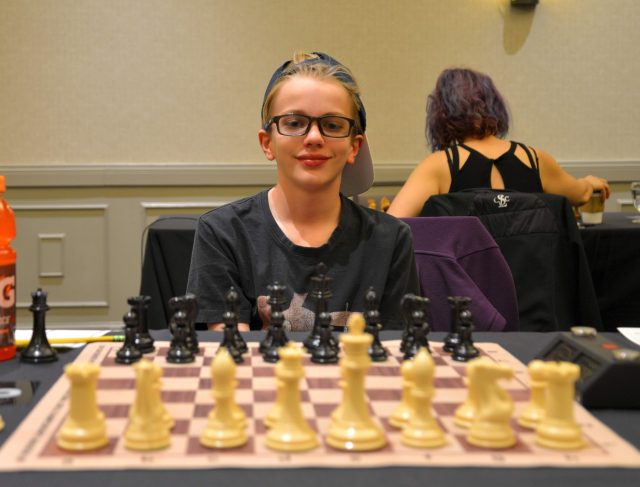 Sullivan McConnell (photo John Brezina)
Sullivan McConnell (photo John Brezina)First place was shared by Jesse Kraai and Danny Rensch. Kraai’s path to the top was marked by steady, error-free play and exploitation of his opponent’s mistakes. Rensch played complex double-edged games and defeated three of the strongest participants including Ippolito, Vigorito, and Fishbein. In fact, since he took a bye in the first round, he won every game he played and had easily the highest performance rating of the tournament. This win was a typical fighting example:
[pgn] [Event "Denver Open 2019"] [Site "Denver USA"] [Date "2019.04.27"] [Round "3"] [White "Rensch, Daniel"] [Black "Ippolito, Dean"] [Result "1-0"] [ECO "B90"] [WhiteElo "2388"] [BlackElo "2339"] [Annotator "John Watson"] [PlyCount "65"] [EventDate "2019.04.26"] [EventType "swiss"] [EventRounds "5"] [EventCountry "USA"] [Source "Mark Crowther"] [SourceVersion "1"] [SourceVersionDate "2019.05.06"] [SourceQuality "2"] 1. e4 c5 2. Nf3 d6 3. d4 cxd4 4. Nxd4 Nf6 5. Nc3 a6 6. Be3 e5 7. Nb3 Be7 8. f3 Be6 9. Qd2 O-O 10. O-O-O a5 11. a4 Na6 12. Qf2 Qb8 $6 {Slow.} (12... Nb4 { gets Black's counterplay going.}) 13. g4 Nb4 14. Kb1 Rc8 15. Bb5 (15. g5 $1 { prevents Black's next.}) 15... d5 $1 {Now things get extremely messy.} 16. g5 Ne8 $6 (16... d4 $1 {holds the balance following} 17. gxf6 dxe3 18. Qxe3 Bxf6 19. Bd7 Bxb3 20. cxb3 Rd8 21. Nd5 Nxd5 22. Rxd5 Be7 23. Rhd1 Ra6 $11) 17. Bxe8 $2 {Tempting, but correct was} (17. exd5 $1 Bf5 18. Rd2) 17... d4 $1 {Dean spots a dynamic intermezzo which turns things around.} (17... Rxe8 $2 18. exd5 Bf5 19. Rd2 {leaves White a clear passed pawn ahead.}) 18. Nxd4 {Gaining two pawns for the piece and hoping to advance on the kingide. Black still stands better after this, but it is an excellent practical decision.} (18. Bb5 dxc3 { threatens ...Bxb3, and Black remains with a powerful attack after} 19. Rc1 Bc4 $1 20. Bxc4 Rxc4) 18... exd4 19. Bxd4 Rxe8 20. f4 Bc4 $2 (20... Bg4 $1 { protects the kingside, e.g.,} 21. Rdg1 Bh5 22. f5 (22. Rg3 Qd6 23. Rh3 g6) 22... Qd6 $17 23. f6 Bf8) 21. f5 $5 (21. Bxg7 $5 {may be objectively better, since} Kxg7 22. Qd4+ Kg8 23. Qxc4 Rc8 24. Qf1 {slows down Black's attack.}) 21... b5 $6 (21... Bd6 $1 $17) 22. axb5 Bd6 $2 (22... a4 $1 {with the idea .. a3 is scary:} 23. f6 Bf8 24. fxg7 Be7 $1 {with unclear complications.}) 23. h4 $5 ({Alternatively,} 23. Bxg7 $5 Kxg7 24. Qd4+ Be5 25. Qxc4 {is at least equal. }) 23... Bxb5 $6 (23... Bg3 24. Qg2 Be5) 24. h5 $1 Nc6 $2 (24... Be5 25. g6 $1 Ra6 $1 26. gxf7+ Kxf7 27. Bxe5 Qxe5 28. h6 {opens kingside lines, but is by no means clear.}) 25. g6 $1 {Suddenly White has an overwhelming attack.} Nxd4 ( 25... Be5 26. gxh7+ Kh8 27. Bxe5 Nxe5 (27... Qxe5 28. Rd5) 28. h6 {and Black's position collapses.}) 26. gxf7+ (26. Qxd4 $1 {is also strong, because} Be5 27. Qd5 {wins a piece.}) 26... Kxf7 27. Qxd4 Bc6 28. Qc4+ Kf8 29. Qxc6 Be5 30. Rd7 Kg8 31. h6 Ra7 32. Rxa7 Bxc3 33. Rb7 1-0 [/pgn]
Before signing off, I should add that I’ve seldom seen such a friendly atmosphere at a swiss system tournament. There were countless post-mortems (a dying custom in many parts of the country) and a heady dose of beer-drinking and conviviality after the evening rounds. This is chess as it should be, and anyone looking for a fun weekend chess getaway should strongly consider attending next year’s event. Note: Photographs courtesy of John Brezina and the Denver Chess Club
Categories
Archives
- December 2025 (22)
- November 2025 (29)
- October 2025 (39)
- September 2025 (27)
- August 2025 (29)
- July 2025 (43)
- June 2025 (25)
- May 2025 (24)
- April 2025 (29)
- March 2025 (29)
- February 2025 (20)
- January 2025 (24)
- December 2024 (34)
- November 2024 (18)
- October 2024 (35)
- September 2024 (23)
- August 2024 (27)
- July 2024 (44)
- June 2024 (27)
- May 2024 (31)
- April 2024 (51)
- March 2024 (34)
- February 2024 (25)
- January 2024 (26)
- December 2023 (29)
- November 2023 (26)
- October 2023 (37)
- September 2023 (27)
- August 2023 (37)
- July 2023 (47)
- June 2023 (33)
- May 2023 (37)
- April 2023 (45)
- March 2023 (37)
- February 2023 (28)
- January 2023 (31)
- December 2022 (23)
- November 2022 (32)
- October 2022 (31)
- September 2022 (19)
- August 2022 (39)
- July 2022 (32)
- June 2022 (35)
- May 2022 (21)
- April 2022 (31)
- March 2022 (33)
- February 2022 (21)
- January 2022 (27)
- December 2021 (36)
- November 2021 (34)
- October 2021 (25)
- September 2021 (25)
- August 2021 (41)
- July 2021 (36)
- June 2021 (29)
- May 2021 (29)
- April 2021 (31)
- March 2021 (33)
- February 2021 (28)
- January 2021 (29)
- December 2020 (38)
- November 2020 (40)
- October 2020 (41)
- September 2020 (35)
- August 2020 (38)
- July 2020 (36)
- June 2020 (46)
- May 2020 (42)
- April 2020 (37)
- March 2020 (60)
- February 2020 (38)
- January 2020 (45)
- December 2019 (34)
- November 2019 (35)
- October 2019 (42)
- September 2019 (45)
- August 2019 (56)
- July 2019 (44)
- June 2019 (35)
- May 2019 (40)
- April 2019 (48)
- March 2019 (61)
- February 2019 (39)
- January 2019 (30)
- December 2018 (29)
- November 2018 (51)
- October 2018 (45)
- September 2018 (29)
- August 2018 (49)
- July 2018 (35)
- June 2018 (31)
- May 2018 (39)
- April 2018 (31)
- March 2018 (26)
- February 2018 (33)
- January 2018 (30)
- December 2017 (26)
- November 2017 (24)
- October 2017 (30)
- September 2017 (30)
- August 2017 (31)
- July 2017 (28)
- June 2017 (32)
- May 2017 (26)
- April 2017 (37)
- March 2017 (28)
- February 2017 (30)
- January 2017 (27)
- December 2016 (29)
- November 2016 (24)
- October 2016 (32)
- September 2016 (31)
- August 2016 (27)
- July 2016 (24)
- June 2016 (26)
- May 2016 (19)
- April 2016 (30)
- March 2016 (36)
- February 2016 (28)
- January 2016 (32)
- December 2015 (26)
- November 2015 (23)
- October 2015 (16)
- September 2015 (28)
- August 2015 (28)
- July 2015 (6)
- June 2015 (1)
- May 2015 (2)
- April 2015 (1)
- February 2015 (3)
- January 2015 (1)
- December 2014 (1)
- July 2010 (1)
- October 1991 (1)
- August 1989 (1)
- January 1988 (1)
- December 1983 (1)


